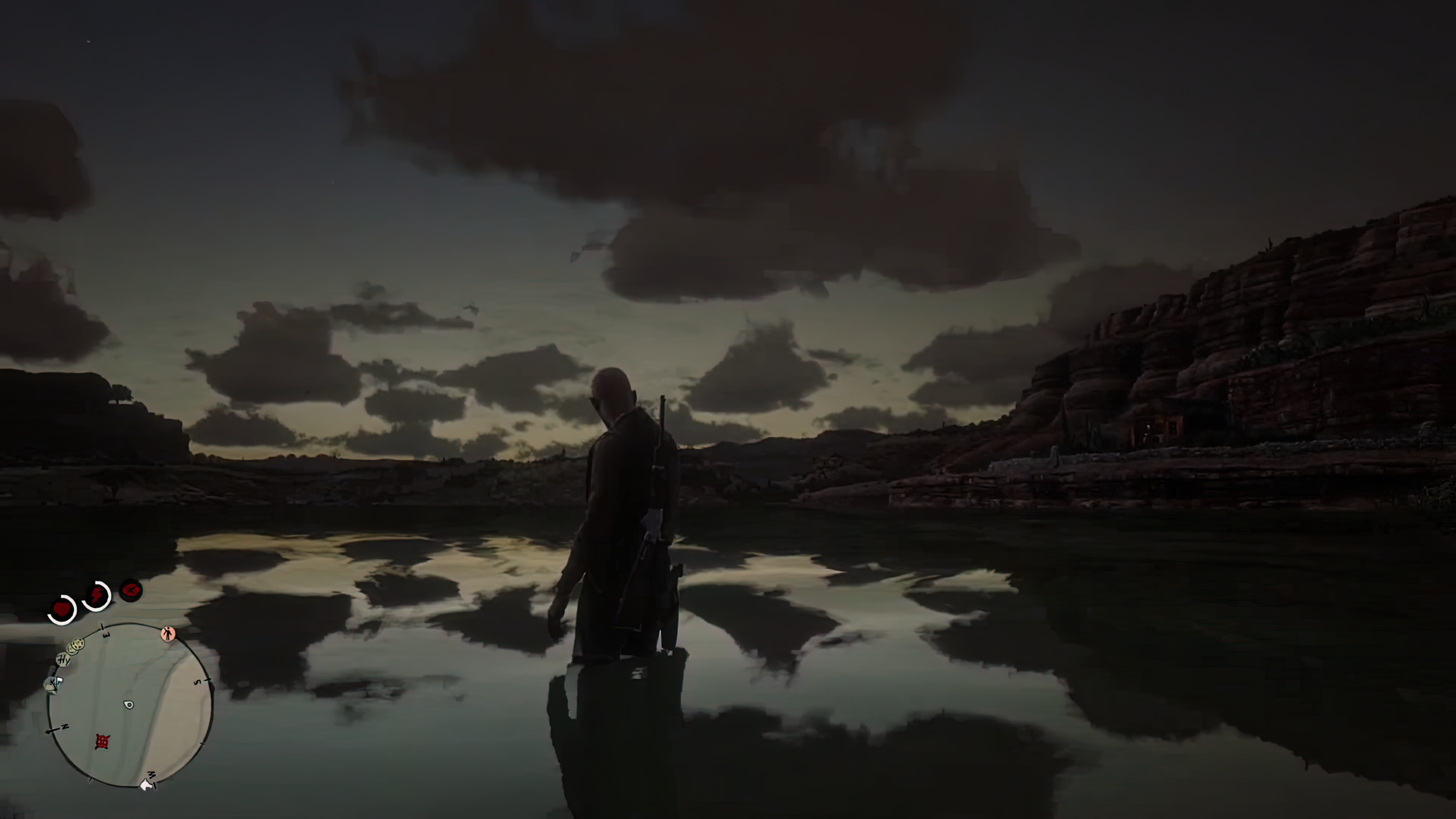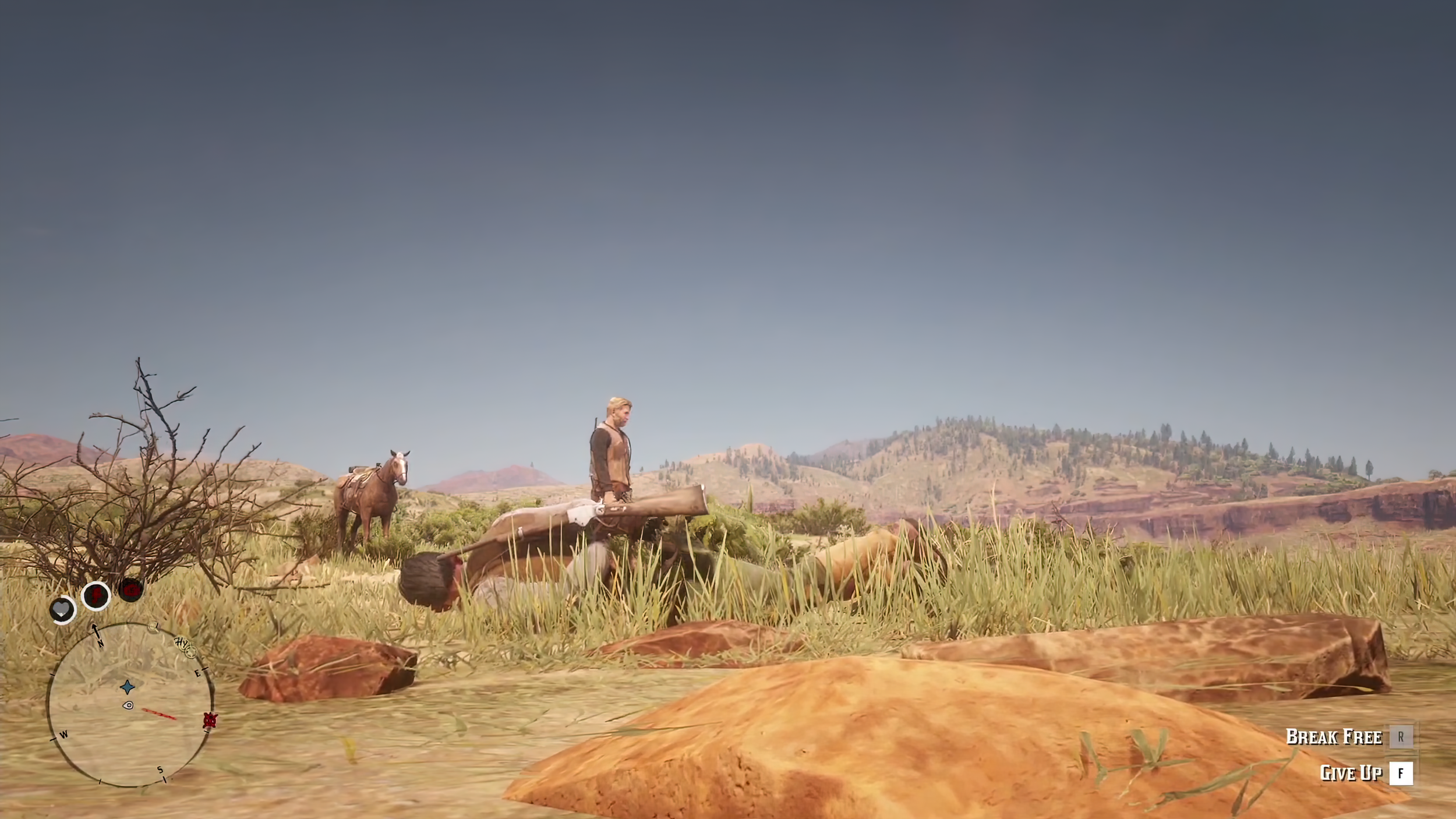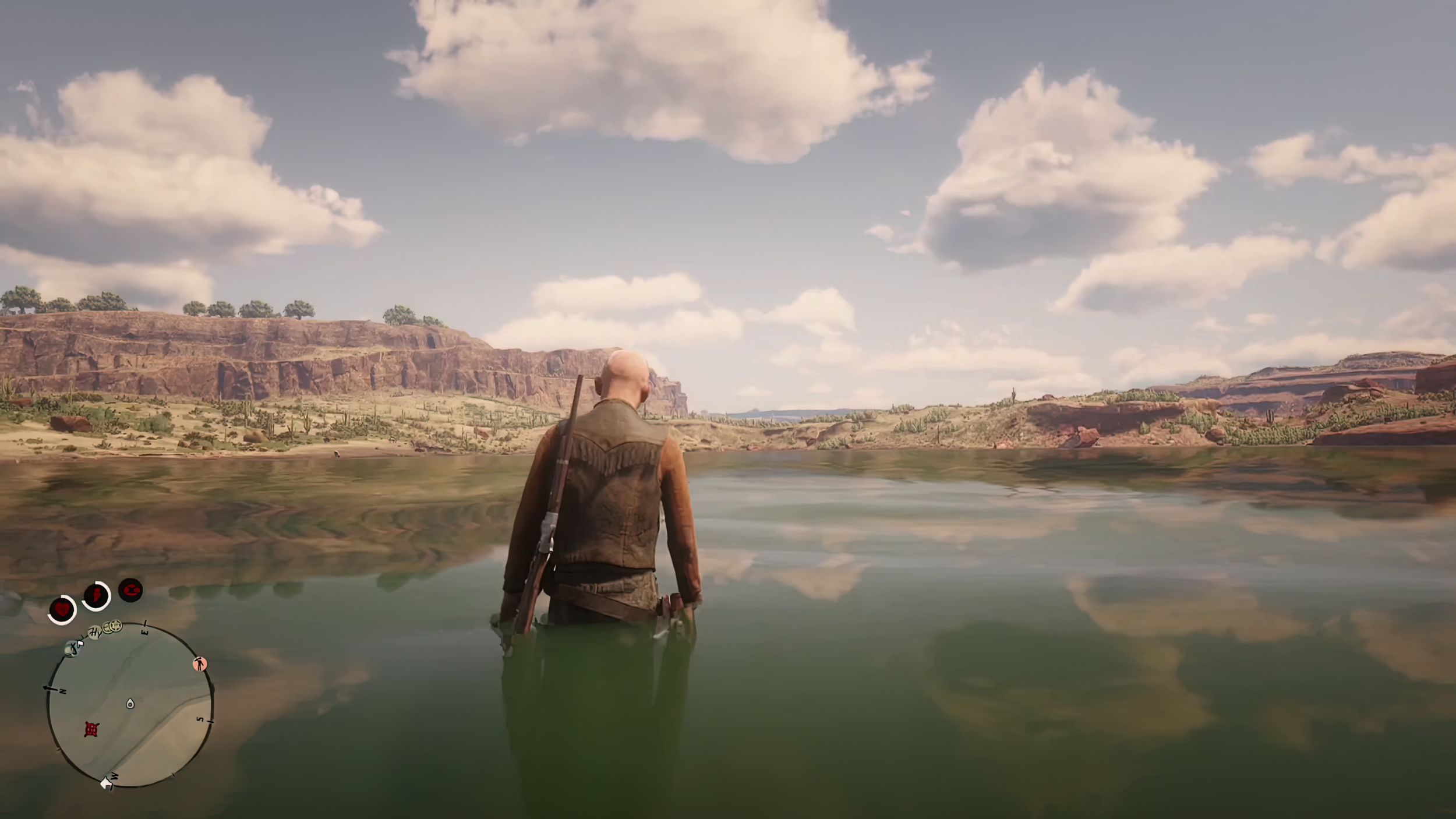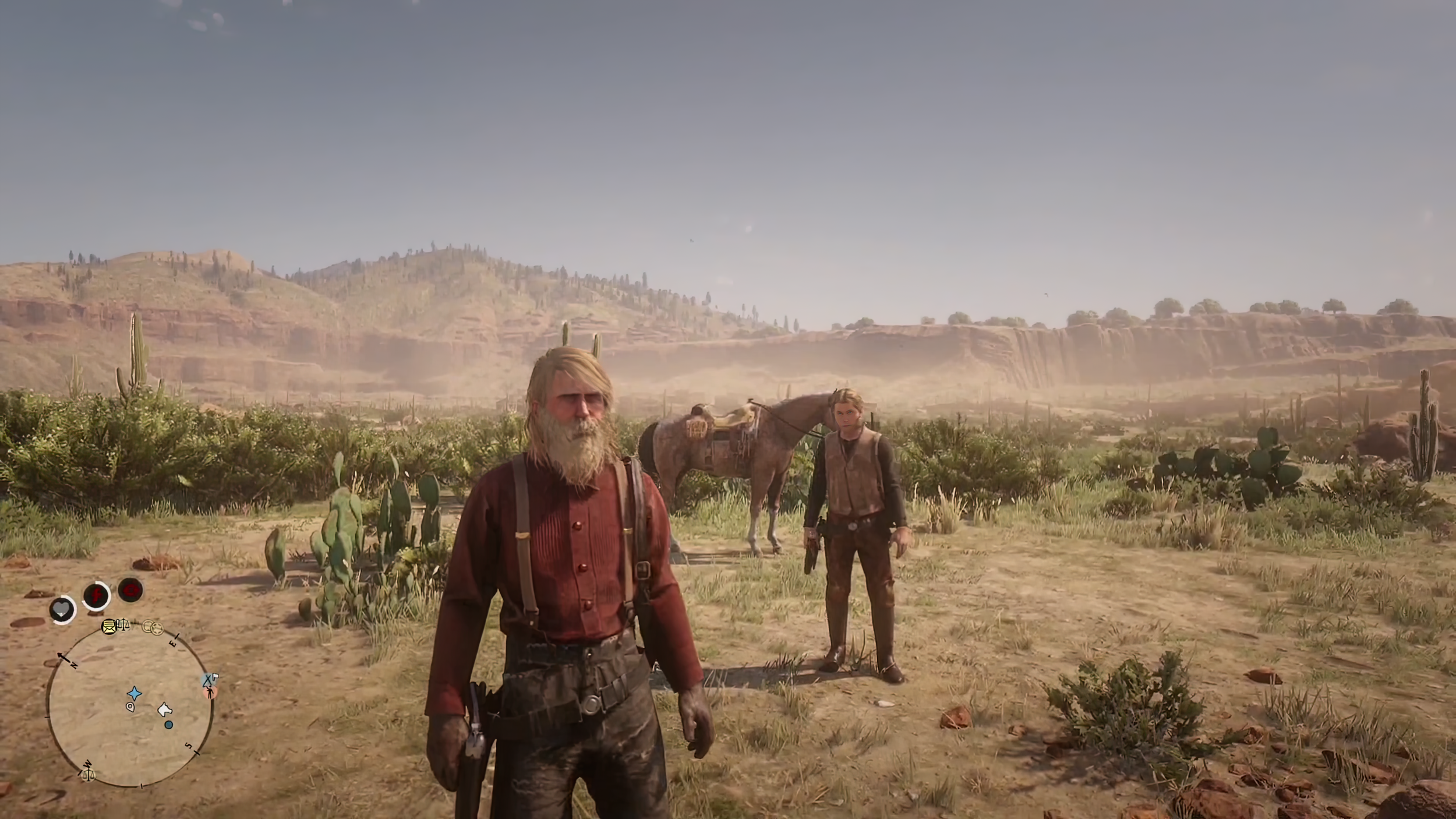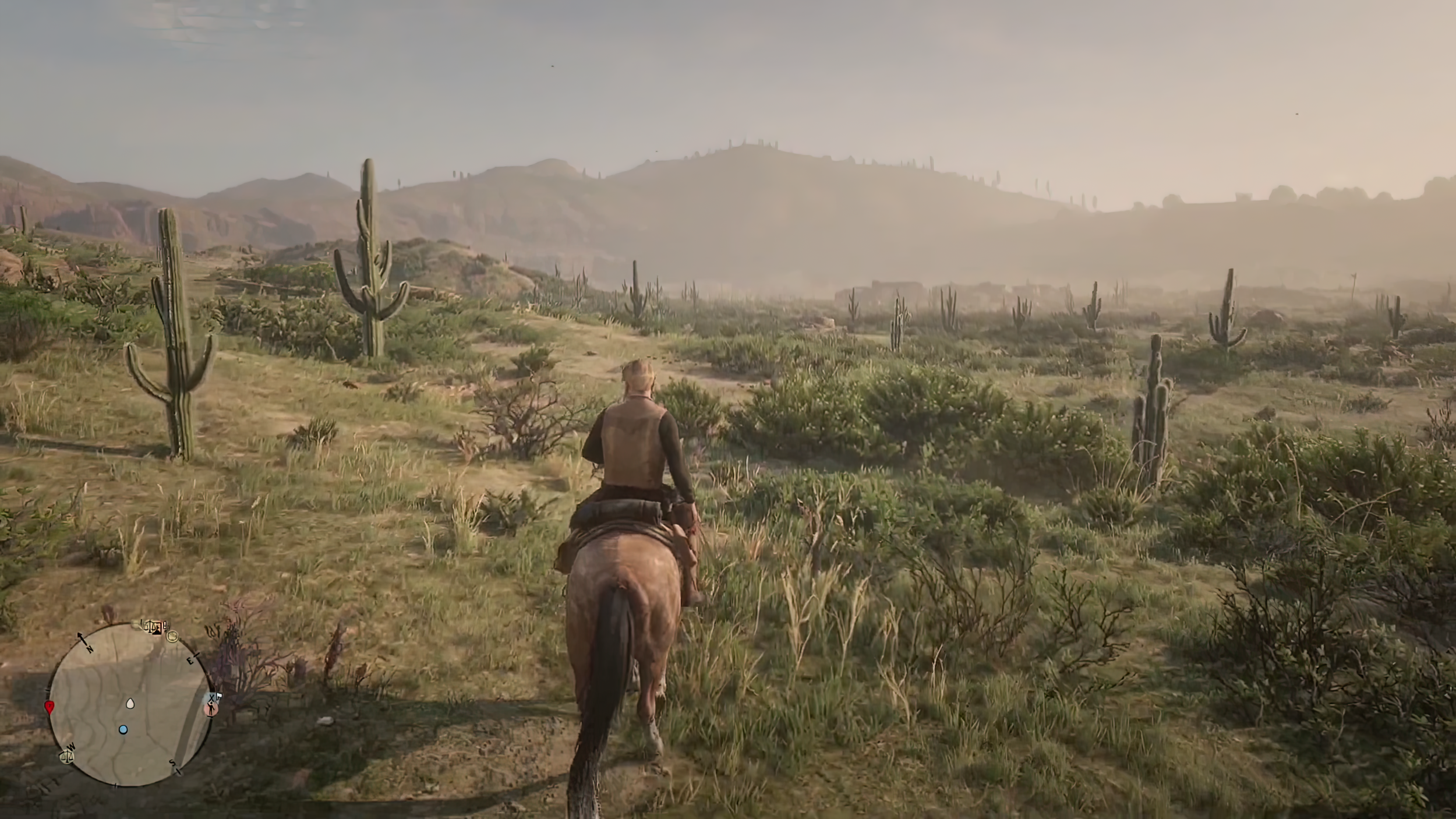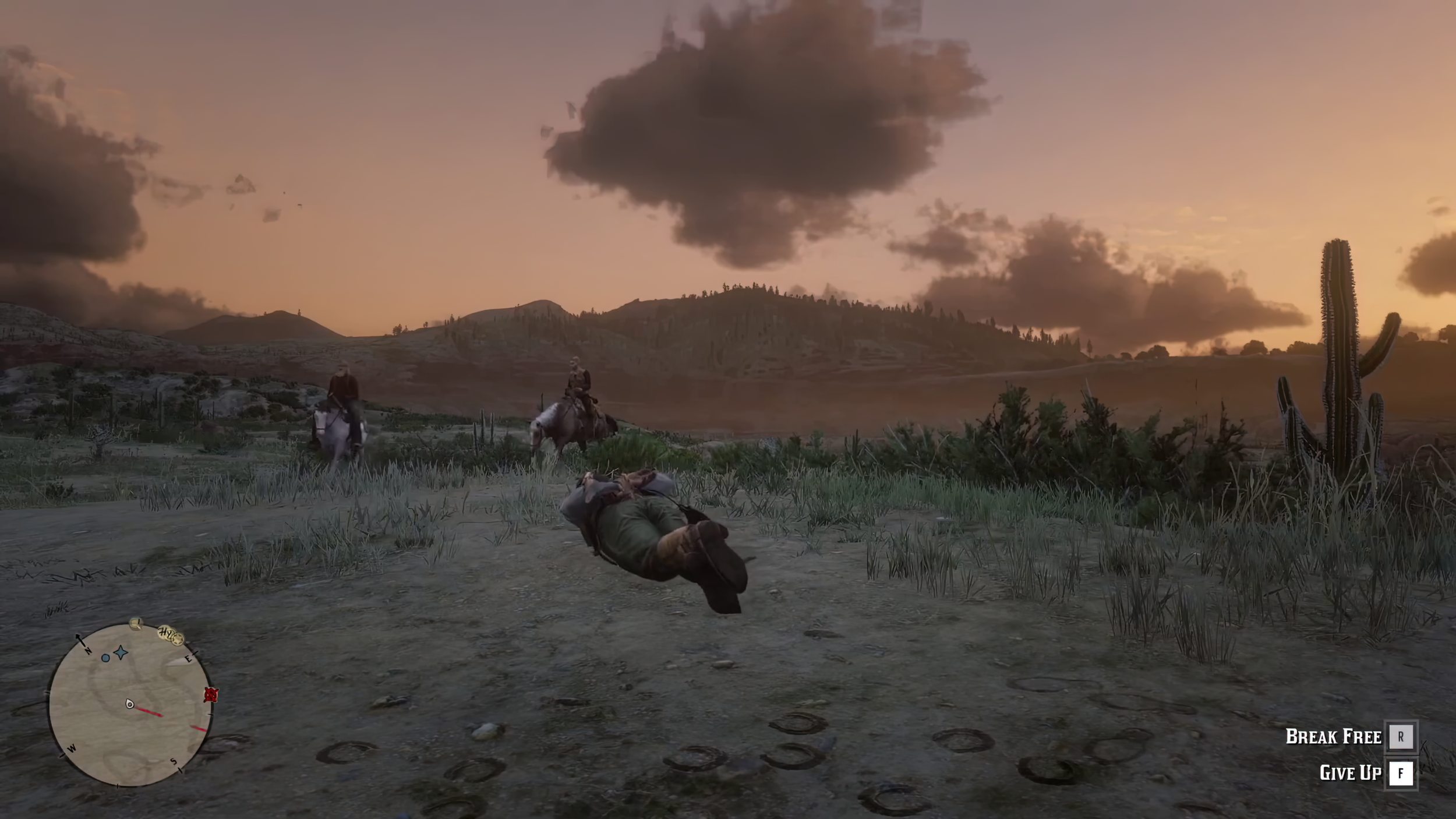Welcome to my Desert Nexus (deep inside my desert heart)
Digital video (1920 x 1080), color, sound, 44’ 50”, 2021, United States
screen recording of a live/virtual performance at Pioneer Works, Brooklyn, New York on June 13 2021
Created by Kara Güt
Welcome to My Desert Nexus is a three-act play performed within a video game, which follows two players within Red Dead Redemption Online as they encounter existential quandaries in the digital desert. Part table-read, part live gaming event, Welcome to My Desert Nexus combines the aesthetics of theater and video games. The original play consists of an in-person presentation performed live at Pioneer Works, Brooklyn, New York on June 13 2021 resembling that of a live gaming event in which the players and their battle stations occupy the stage. Additionally, Welcome to My Desert Nexus was simultaneously streamed on the internet and accessible to anyone. The performance featured the four actors on stage controlling their avatars and reading their lines live. The narrator, in addition to controlling an avatar, performed live cuts via video switcher, allowing the screen to switch between the actors’ perspectives based on who was talking. This specific iteration of Welcome to My Desert Nexus, which is now presented on VRAL, starred Tommy Martinez as Charlie, Emma Levesque-Schaefer as Frances, Noah D’Orazio as Shepherd, and Kara Güt as Narrator. The original soundtrack was composed by Justin Majetich.
Kara Güt investigates the new contours of human intimacy shaped by an increasingly pervasive online lifestyle, constructed detachment from reality, and the power dynamics of the virtual. Using image and screen-based media, Güt explores the ontological necessity of certain digital spaces. She is specifically interested in how the patriarchal conversation within these contexts can be subverted by the artists and the participants’ intervention to generate new meaning. Working with video, screen capture, and the web, video games, and other digital spaces, Güt creates artworks that are sculptural in nature. She is interested in expressing the mythos of the digital and its manifestations in the physical realm. This notion – which takes the form of objects that play with language, translation, faux-intimacy, consumerism, and a metamorphosis born from the lore of digital, and internet lifestyles – informs her practice. A multidisciplinary artist with an MFA from Cranbrook Academy of Art, Güt is the recipient of the Peter MacKendrick Endowment for Visual Artists, Güt has been featured on Refigural Magazine, The Unstitute, and the Detroit Center for Contemporary Photography among others. Her work is part of the Cranbrook Art Museum collection as well as several private collections. Güt currently lives and works in Columbus, Ohio.
Gemma Fantacci: Your artistic practice is very eclectic as you use a wide variety of media – including photography, sculptural elements, video games, mods, typography, and found footage – to investigate internet subcultures and human intimacy within hyperreal spaces. Can you describe your upbringing and the major influences that contributed to the shaping of your work over the years?
Kara Güt: I’ve always had a fascination with telling fantasy stories and thinking up imaginary worlds. As a kid, I wrote plays and made short videos starring friends and family members. Having access to a VHS camera allowed me to experiment with video at an early age. My friends and I were very interested in remakes, trying to copy already existing movies or games. Our most ambitious project was a shot-for-shot remake of the film What’s Up, Doc? (1972) that ran over four hours long and took an entire year to complete. During that time, I was deeply embedded in the online fandom of The Lord of the Rings books and movies, and was using the internet as a connection to the “real world” from the perspective of a kid growing up in the suburbs. I was a big gamer, playing titles for home computers like Myst, Riven, and other click-through mystery adventure games. I wrote constantly, both IRL and in word-processing, building entire worlds with languages and histories, trying to imitate Tolkien.
In undergrad, I majored in photography, influenced by the works of John Baldessari and Pipilotti Rist. I was interested in translating performance and narrative into photographs and videos. Two projects that were foundational to my thinking were Cyprien Gaillard's Real Remnants of Fictive Wars (2004) and Let the Good Times Roll (2004) by Stanya Kahn and Harry Dodge.
In grad school at Cranbrook Academy of Art, I was influenced by the works of Peggy Ahwesh, Cecile B. Evans, and Sondra Perry, making work that contained narrative and performance within hyperreal space. I’m often compelled to use my most immediate materials to create new works, and often, these materials reflect a hybrid real/hyperreal existence.
Gemma Fantacci: Welcome to My Desert Nexus is a compelling three-act play combining different aspects of performance and online gaming, IRL acting, and avatar dramatization. How did you come up with the idea of a play based on Red Dead Redemption Online concerning the contemporary never-ending tension between reality, fictitious expectations, and the paranoia stemming from this relationship?
Kara Güt: For a long time, I’d been thinking about the concept of the frontier and wilderness as our western culture has defined it. I was thinking about the implications of referring to digital space as yet another frontier, when a friend referred me to Red Dead Redemption (Rockstar, 2010). I wrote about the game as a collapsed metaphor: a “frontier” within a “frontier,” both of them standing as ideal spaces for infinite creation, when in truth they were flat concepts, circling around each other. The Frontier presented in Red Dead Redemption was a facade upon which the player could paint their fantasies, just as the frontier of digital space is a facade for the same. In thinking about the facade and the false promise of infinity, I began crafting a narrative. Then, with the release of Red Dead Redemption Online (Rockstar, 2018), people were co-oping and role playing together, making up their own versions of antiquity. I started writing characters that felt, to me, like a cosplay someone had become lost within, as if they used to have a storyline, but the threads of it had been forgotten along the way.
Gemma Fantacci: As I read the script and watched the play, I felt like I was presented with four different characters (i.e., the Narrator, Charlie, Frances, Shepherd), each with their own point of view, but also (perhaps) with four iterations of the same person, somebody suffering from schizophrenia resulting in a “surplus of vision which embraces multiple perspectives”, to use Grishakova’s words. Can you describe the process behind the creation of this palette of characters?
Kara Güt: I was interested in crafting characters around a single question of existence: Without death, what is the point of infinite life? I used the question as a stand-in for, in one sense, the infinite scroll and the proliferation of content. What can we do in the face of infinity? How can we create a hierarchy of importance when all information is readily available, if not engineered to request our immediate attention?
At the time, I was reading the play No Exit (1944) by Sartre, and felt that this question of infinite life would result in the torture of its victims. Without death, the characters would face each other for eternity. I wanted to create four separate viewpoints that addressed this state of being.
“In this place there is no death, so we must find other ways to kill,” is uttered by Shepherd, who replaces the instinct for survival with an instinct of violence. To fill this void, Charlie places belief in a higher power, claiming to have been assigned a hero’s journey, filling his life with a sense of importance, although that wanes into despair. Frances, at first an optimist, eventually realizes they must embrace meaninglessness in order to ‘achieve true freedom’ within a world void of death. The Narrator is the most mythological of the group, embracing a Sisyphean role, forever wading into the water, drowning, only to respawn again.
I wanted to emphasize the inherent differences in perspectives while also changing the characters’ roles throughout the story, showing their plasticity within the unchanging landscape. The play ends as a tragedy, but also ends how it begins: nothing about the world has fundamentally changed. Despite our characters’ various perspectives and strategies, they’ve failed to find a way out, or a way forward.
Gemma Fantacci: Although each character’s journey is different and unique, all of them are struggling to make sense of reality: the one we inhabit with our physical bodies, but also the ones we traverse with our avatars. The interstices between these realities are also crucial. Charlie experiences a change of heart throughout the journey. At first, he embraces the narrative but at the end he laments that «I have followed my journey to the letter, and what has it gotten me?». His version of reality has broken down and he’s now stuck in a sort of limbo, physically and mentally. Here, we understand that there is a fifth — and perhaps most important — character, the desert, a symbol of freedom and possibilities at first, of the mantra «I did it», as Jean Baudrillard writes in his seminal book America (1988), and then of paranoia and disbelief. What is the role of the desert in your play?
Kara Güt: As you alluded to in your question, the desert does represent a limbo of sorts. It is just another iteration of the “American dream,” or a similar mutable form that takes the shape of our closest held contemporary desires, never to be fulfilled. Further along in that same monologue, Charlie says, “[I’ve] lost sight of what we are, just grains of sand in its hourglass…” referring to both the conception of the desert and the gamespace at once. He has finally become disillusioned, or perhaps admits to something he’s known deep down all along: the desert is just another container to become lost inside, but nonetheless contained. This could be seen as a loss of immersion, or a failure of his suspension of disbelief, what we do when we relate to media through our various devices and the momentary glitches and plot holes that remind us of our engagement.
Gemma Fantacci: Welcome to My Desert Nexus made me think about our broken expectations about the internet and online spaces as a form of escapism. It’s easy to create a fictitious one and make up (or fake) aspirational lifestyles. However, it’s becoming more and more difficult to draw a line between what is real and what is not. It reminds me of one Soulellis’s talk on the infinite feed, where he said that nowadays it seems to be stuck in a “durational time-space” that forms around images and videos, «that seems to go on forever. The story is never resolved, because it doesn't develop; it’s simply a constant becoming». We basically live in spaces where it is difficult to discern threshold moments and return to “reality”, whatever that means. We’re stuck in our personal fictional nexus composed of layers of narrative that ultimately do not construct a cohesive story. How do you experience this conundrum? Is your artistic practice a “coping strategy”, so to speak?
Kara Güt: In the script for Nonspace Canon – beta, a video I made in 2019, I ask the question: “Do you come here to the nonspace to feel joy, or pain, or both?”. I feel that the answer is certainly both, but phrasing it as a question gives an illusion of choice. We are facing a space we enter both willingly for pleasure and necessarily for work, commerce, news, and our basic needs. Those that argue for the individualist approach of “just log off” don’t consider the larger systems in place that keep us within its borders. With that in mind, I think we need to create sustainable strategies for existing in digital space, as it will continue to exist as a more and more pervasive system.
Gemma Fantacci: The characters from Welcome to My Desert Nexus seem unable to overcome their flawed condition. Likewise, we feel stuck in limbo. Such a condition worsened last year with the pandemic: suddenly, digital spaces became our main reality as the “real world” was banned and canceled altogether. Now more than ever, social media and gaming spaces have become the preferred venue to create, curate and share the best version of ourselves. As Frances put it, «we’ve launched ourselves into the abyss: an unknown made from» ads, influencers, reels, and aesthetically pleasing feeds. You also explored the idea of rejecting false expectations and the highly curated process of self-presentation through stock photos and videos in your project ESC (2017). But does one really want to escape from this golden cage?
Kara Güt: The project ESC imagined an “escape to the virtual” as a scripted, commercialized vacation. The video at the heart of the piece accuses the viewer: “The tools you use have become simplified. Instead of creating, you are choosing. Instead of innovating, you are repeating.” It comments on the smaller and smaller bandwidth we have for imagining better futures, alternative outcomes, or the ability to think for ourselves when presented with tidal waves of content specifically curated for our constant engagement. To answer the question cynically, no, I don’t think we want to leave this golden cage. It would mean a disconnection from the content we long for. And although, like Charlie, we become painfully aware of our container, we will still “walk deep into that desert alone.” I don’t know if I have a solution for what future lies ahead, but any effort to better express our societal consciousness might result in a path forward.
Gemma Fantacci: In the introductory section of the Working Script for Welcome to My Desert Nexus, you mention that the performance could be suited to “any video game with an online element”. Have you considered adapting your play to other video games, such as Grand Theft Auto Online or Animal Crossing for instance? Can you think of another setting that would be ideal to further examine Baudrillard’s concept of the désert du réel (desert of the real)?
Kara Güt: Absolutely! When I first began writing the play, I was worried I would never get the chance to present it live, if at all, so I released the script out into the world as a chapbook. I would love it if someone were to adapt it for a different game, and at some point I will most likely adapt it for a similar open world game. I am a proponent of open-source media, and love the idea that, if someone wanted to, they could remake a video of mine, using the list of sources and materials I leave in the credits of my videos.
Gemma Fantacci: I am very interested in the sculptural aspect of your artistic practice and the video game weaponry theme that recurs in several of your works. How does the sculptural materiality of your work interface with the inquiry of the hyperreal space? And what’s up with this very American fascination (obsession?) for weapons in games?
Kara Güt: I don’t know if I can speak to the question of “why” in terms of fascination and obsession, but the outcome is so interesting to me. In my video he wishes for the cloths of heaven (2017), I show a collection of digital weapons turned physical by fans. Each weapon began its life first as a digital object, and was imperfectly transformed, through immense care, into a physical object to be wielded by the user. Using this concept of the digital artifact – the imperfect translation inspired me to create sculptures in this same vein.
Gemma Fantacci: Another important part of your work is the use of Skyrim and the mod “Immersive Lover’s Comfort” by flexcreator to investigate themes like intimacy in the performative space of digital games. This theme returns in some of your sculptures and photos as well, in the form of swords or the chain mail. What’s your relationship with Skyrim and why, in your opinion, is it widely used among artists to investigate and examine not only different aspects about contemporary society but also gaming culture? How would you describe your personal relationship to video games and to the gaming community?
Kara Güt: I think that Skyrim (Bethesda, 2012), reached a lot of casual and first-time gamers, and made the RPG more ‘mainstream’ for my generation. This, coupled with the massive modding community surrounding Skyrim, made it ideal for new creations that could quickly convey ‘fantasy’ to the viewer. I want to communicate through fantasy, and by proxy, gaming and other utilizations of digital space, the ways in which our collective escapism through mediation can be both beneficial and alienating. When I first began to work with Skyrim as a medium, it was my first foray back into console gaming since childhood, but I’ve always had a relationship with PC gaming in the form of adventure games. I’m a fan of the Dark Souls series, but in general I gravitate toward indie titles. Aside from my artwork, I consider myself a casual gamer, although I’m currently teaching myself how to speedrun Dark Souls, which has proven to be difficult so far!
Gemma Fantacci: I’d like to ask you about the Welcome to my desert nexus/Working script version printed by Clare Gatto with Bulk Space for Printed Matter’s Art Book Fair, 2021. You and Clare have worked together on other occasions, as for Void 0 (2017) for example. How did your collaboration begin? Can you describe your artistic bond?
Kara Güt: Clare and I met while studying photography in undergrad at Ohio State University. We were both interested in performance as well as image-making, and that grew into a collaboration we’ve maintained over the years. After undergrad, Clare and I both attended Cranbrook for graduate school to study under Liz Cohen, which felt like a natural progression for our image-based performative work. Since then, we’ve continued to show together, work together, and create projects side by side. Our current collaboration is called The Cloud of Unknowing, a physical/digital project that will result in a video game. Our most recent show Spawning Point is the first “level” of the game-in-progress. The exhibition was installed at Stone House Art Gallery in Charlotte, NC, and then 3D scanned as assets for the larger game. Our next exhibition will be at Dream Clinic in Columbus, OH, and will follow the same process of physical to digital asset building. Clare currently lives in Detroit, Michigan, and helps run BULK Space along with Jes Allie, Jova Lynne, Meg Kelley, and Sara Nishikawa. BULK Space is always working on new and exciting projects and events. I recommend that everyone check them out!
Gemma Fantacci: Is there anything else you would like to add?
Kara Güt: I want to acknowledge all of the amazing people that worked on this project with me. I wouldn’t have been able to bring this vision into reality without all of the actors and behind-the-scenes help. Artwork, especially artwork that involves technology, oftentimes cannot exist without the help of a community.
Below are the credits for the piece:
Welcome to my Desert Nexus
Starring:
Tommy Martinez as Charlie
Emma Levesque-Shaefer as Frances
Noah D’Orazio as Shepherd
AV Department:
Matthew Mann
Federico Romero
Prop Fabrication:
Claire Ronan
Original Soundtrack:
Justin Majetich
Alternate Performers:
Todd Kunkler
Harrison Moenich
Cameron Granger
Documentation:
Samuli Haavisto
Clare Gatto
Special Thanks To:
Pioneer Works Staff
A CLOSER LOOK AT WELCOME TO MY DESERT NEXUS
Welcome to my Desert Nexus (deep inside my desert heart)
Digital video (1920 x 1080), color, sound, 44’ 50”, 2021 (United States)
screen recording of a live/virtual performance at Pioneer Works, Brooklyn, New York on June 13 2021
Created by Kara Güt (2021)
Courtesy of Kara Güt (2021)





